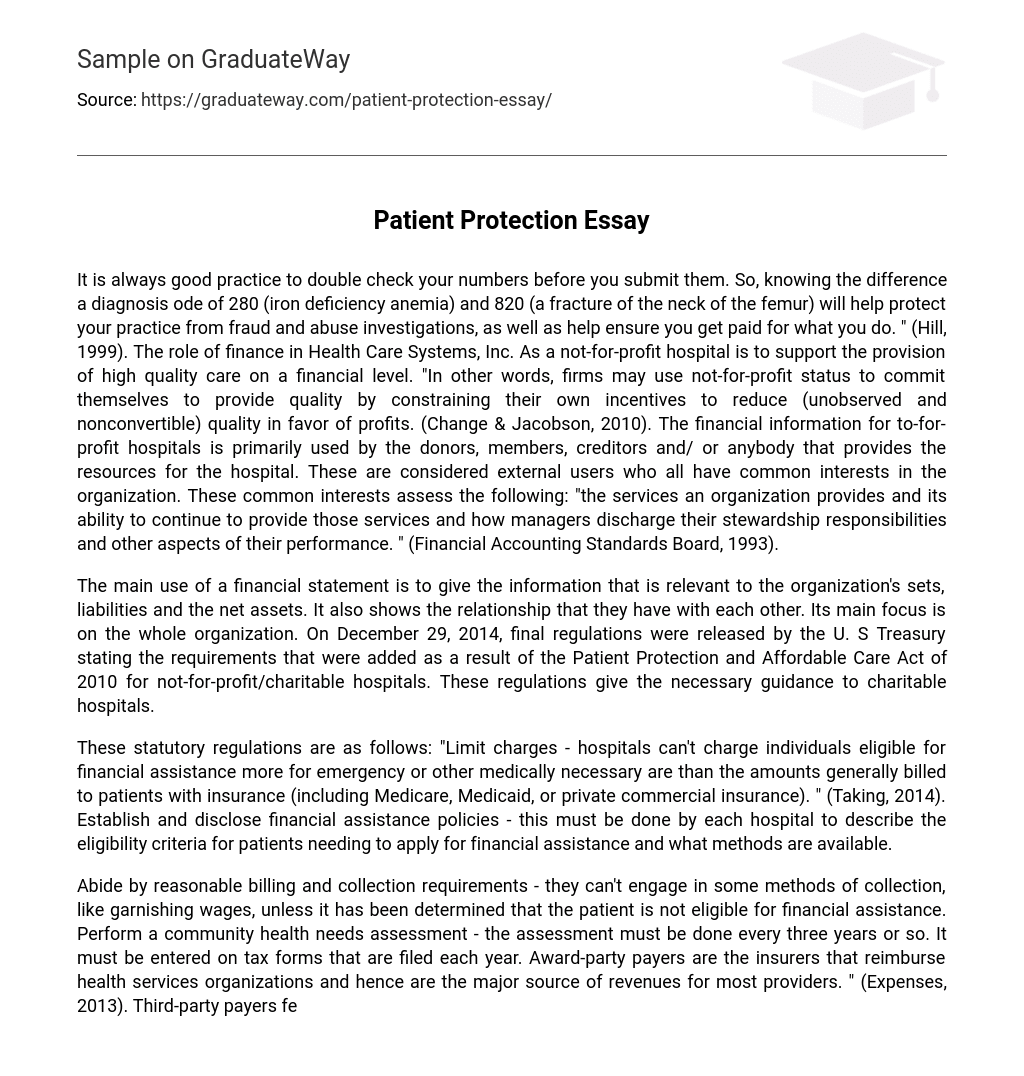It is always good practice to double check your numbers before you submit them. So, knowing the difference a diagnosis ode of 280 (iron deficiency anemia) and 820 (a fracture of the neck of the femur) will help protect your practice from fraud and abuse investigations, as well as help ensure you get paid for what you do. ” (Hill, 1999). The role of finance in Health Care Systems, Inc. As a not-for-profit hospital is to support the provision of high quality care on a financial level. “In other words, firms may use not-for-profit status to commit themselves to provide quality by constraining their own incentives to reduce (unobserved and nonconvertible) quality in favor of profits. (Change & Jacobson, 2010). The financial information for to-for-profit hospitals is primarily used by the donors, members, creditors and/ or anybody that provides the resources for the hospital. These are considered external users who all have common interests in the organization. These common interests assess the following: “the services an organization provides and its ability to continue to provide those services and how managers discharge their stewardship responsibilities and other aspects of their performance. ” (Financial Accounting Standards Board, 1993).
The main use of a financial statement is to give the information that is relevant to the organization’s sets, liabilities and the net assets. It also shows the relationship that they have with each other. Its main focus is on the whole organization. On December 29, 2014, final regulations were released by the U. S Treasury stating the requirements that were added as a result of the Patient Protection and Affordable Care Act of 2010 for not-for-profit/charitable hospitals. These regulations give the necessary guidance to charitable hospitals.
These statutory regulations are as follows: “Limit charges – hospitals can’t charge individuals eligible for financial assistance more for emergency or other medically necessary are than the amounts generally billed to patients with insurance (including Medicare, Medicaid, or private commercial insurance). ” (Taking, 2014). Establish and disclose financial assistance policies – this must be done by each hospital to describe the eligibility criteria for patients needing to apply for financial assistance and what methods are available.
Abide by reasonable billing and collection requirements – they can’t engage in some methods of collection, like garnishing wages, unless it has been determined that the patient is not eligible for financial assistance. Perform a community health needs assessment – the assessment must be done every three years or so. It must be entered on tax forms that are filed each year. Award-party payers are the insurers that reimburse health services organizations and hence are the major source of revenues for most providers. ” (Expenses, 2013). Third-party payers feature three parties.
The first party is the patient or the person that is responsible for paying the bill. The second party is the doctor and/or any healthcare organization that is providing the care. Since the second party provides the care, they are also known as the provider. The third party includes insurance companies that are not involved in he care and/or healthcare agencies that pays the provider. Reimbursement means to pay someone back for their out-of-pocket expense for payment of services rendered. There are a number of methods used for reimbursement used by healthcare organizations.
There are four main payment methods that include: Fee-for-service – “physicians are paid for every service and test that they provide based on the Usual and customary charges of physicians in the local area. ” (Reimbursement Methods, n. D. ). Discounted-fee-for-service – it is almost the same as the previous payment method except the payment is based n either a fee schedule or a pre-determined discount. Capitation – each enrollee pays a fixed amount per enrollee, not the service and it is paid monthly. Salary “physicians are paid a fixed weekly or monthly amount, and pay is not tied to enrollees or services rendered. (Reimbursement Methods, n. D Some other methods types are: Cost-based – the provider is paid for incurred costs for services provided to an insured population. Charge-based – payment is made according to a choirmaster or rate schedule. Prospective payment – pays the expected costs instead of historical costs. Rates are determined prior to services being entered. The diagnosis code is the most important information listed on an insurance claim form. “The code numbers entered there is based on the physician’s opinion of the patient’s specific illness(sees), sign(s), symptom(s), and complaint(s). (Diagnostic Coding, n. D. ). If a diagnosis is coded wrong, it affects all things associated with billing and payment processes. Insurance carriers use these codes to process claims. If there is an error with the code, then the insurance carrier gets the wrong information about the patient. Other than causing unnecessary confusion, it causes processing to be delayed, along with he claim being denied or the payment being reduced. It also throws up a “red flag” regarding billing fraud. “Diagnostic coding follows a five-step process: Step 1 – Locate the statement of the diagnosis in the patient medical record.
Step 2 Find the diagnosis in the ICED-9-Cam’s Alphabetic Index. Step 3 – Locate the code from the Alphabetic Index in the ICED-9-Cam’s Tabular List. Step 4 – Read all information and sub-classifications to get the code that corresponds to the patient’s specific disease or condition. Note fourth- and fifth-code requirements and exclusions. Step 5 – Record the diagnosis code on the insurance claim, and roof-read the numbers. ” (Diagnostic Coding, n. D. ). In conclusion, regardless of the healthcare facility you go to, there is always a third-party payer involved in your care.





